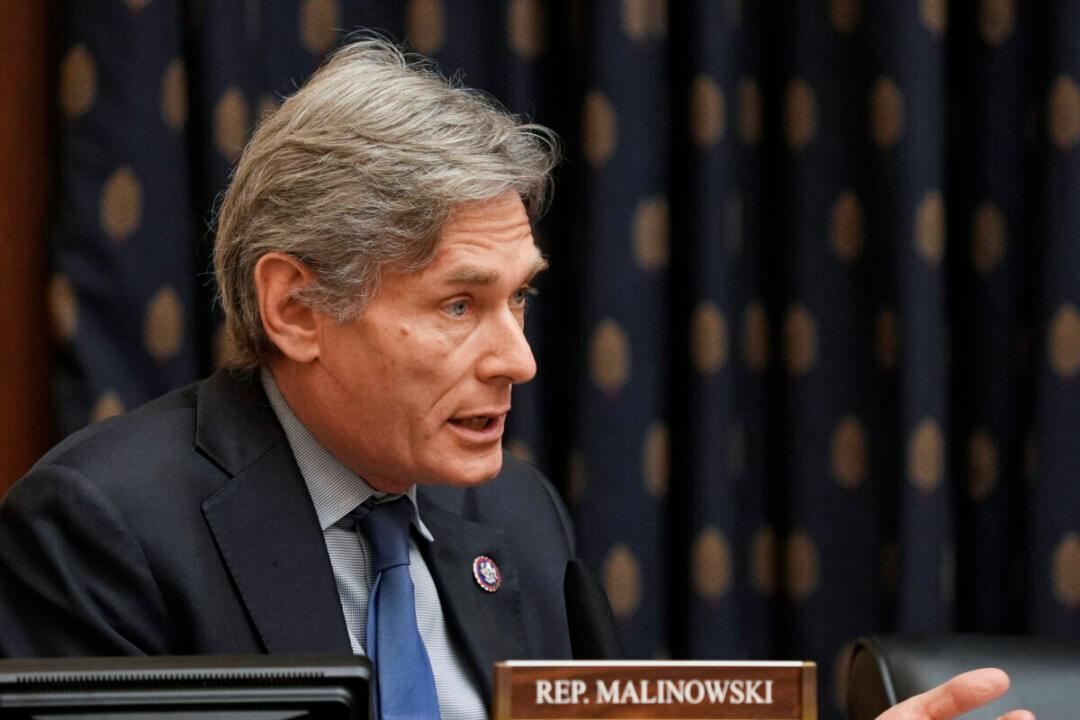FORKED RIVER, N.J.—Founders of New Jersey’s fledging Moderate Party are vowing to continue their efforts toward ending the state’s century-old ban on “fusion voting” after their petition to place a candidate already endorsed by one of the two major parties under their banner as well on November’s ballot was rejected in early June.
That candidate, two-term U.S. Rep. Tom Malinowski (D-N.J.), is being challenged by Republican Thomas Kean Jr., in a rematch of their 2020 7th Congressional District (CD 7) race decided by 5,329 votes, or less than 1 percent, in one of the nation’s most-watched elections.
In a July 6 New York Times guest essay titled “A Viable Third Party Is Coming, and It’s Starting With a New Jersey Lawsuit,” Malinowski wrote that there is momentum across the country for centrist alternatives that would “empower swing voters to save our democracy from toxic polarization” engendered by Democratic and Republican parties hijacked by extremists on the left and the right.
But five weeks after state Secretary of State Tahesha Way rejected the nascent Moderate Party’s petition to place Malinowski as its 7th District candidate on the Nov. 8 ballot, time is running out for legal action to produce a decision before vote-by-mail ballots must be dispatched on Sept. 24.
Inaction over a vowed lawsuit has fostered ridicule from Republicans and the Kean campaign who see the newly minted party as a stunt designed to distract voters from the fact that Malinowski is a Democrat who supports Biden administration policies that they say have failed and are out-of-step with the district’s voters.
“Fusion voting” isn’t the same as voting for “third party” hopefuls placed on ballots against candidates sponsored by the two major parties. Under this system, multiple parties can nominate the same candidate, who can appear more than once on the ballot, and their vote totals are combined.
Fusion voting is standard in Europe, where multiple parties form alliances and coalitions to cross-nominate common candidates in national and European Union elections. In May, a constellation of minor parties and independents in Australia banded together to elect Labor leader Anthony Albanese as prime minister.
Fusion voting was common in the United States from the 1800s until the 1920s when, under pressure from the two major parties, more than 40 states banned candidates from being placed more than once on the same ballot.
Only eight states now allow “fusion voting”: Connecticut, Delaware, Idaho, Mississippi, Oregon, South Carolina, Vermont, and New York.
“Fusion voters” have affected numerous races in these states. In the 2010 Connecticut governor’s race, Democrat Dannel Malloy, who was also listed on the Working Families Party ballot line, garnered an additional 26,000 votes, which proved to be the key to his victory.
Fusion voters are a crucial constituency in New York, where the two largest “third parties” don’t usually run their own entries but can influence what candidates are nominated by the two major parties by placing them on the ballot under their banner as well.
New York’s Working Families Party usually aligns with Democrats, and the state’s Conservative Party usually supports Republicans. These cross-nominations can significantly influence success in general elections.
Legal efforts to eliminate bans on fusion voting have been thwarted over the last 30 years by a U.S. Supreme Court ruling that allows states to ban the practice, and in state court rulings that upheld prohibitions on cross-party nominations.
In 1994, the Twin Cities Area New Party petitioned the Minnesota Secretary of State’s Office to allow a state House candidate who was running on the Democratic–Farmer–Labor Party line as the New Party’s candidate.
The party sued when the petition was denied, claiming the prohibition violated First and 14th Amendment free association rights. After a district court ruled in favor of Minnesota, the U.S. 8th Circuit Court of Appeals reversed that decision, which the state appealed to the U.S. Supreme Court.
In 1997, the Supreme Court ruled 6–3 in favor of Minnesota, finding in Timmons v. Twin Cities Area New Party that the ban on fusion voting didn’t unduly burden the free association rights of citizens.
“We conclude that the burdens Minnesota’s fusion ban imposes on the New Party’s associational rights are justified by ‘correspondingly weighty’ valid state interests in ballot integrity and political stability,” the majority opinion written by Chief Justice William Rehnquist stated.
The ruling offered “no views … concerning the wisdom of fusion,” the opinion said. “It may well be that, as support for new political parties increases, these arguments will carry the day in some States’ legislatures. But the Constitution does not require Minnesota, and the approximately 40 other states that do not permit fusion, to allow it.”
It is, the court ruled, a state matter. In a 2019 challenge to Pennsylvania’s fusion ban, the Working Families Party sued after its petition to cross-nominate a Democratic Party candidate was denied. The state’s Supreme Court upheld the prohibition in a 4–3 ruling.
Amid polarization where increasingly a significant component of voters registered with the two major parties are unhappy with what they perceive to be extreme ideological drifts—and the number of independent voters unaffiliated with either continues to grow nationwide—the idea of fusion voting and coalition-building is gaining traction as an alternative to simply voting for a third-party candidate who usually has little chance to win.
In Utah, for instance, Evan McMullin is running against incumbent GOP Sen. Mike Lee (R-Utah) as a center-right independent endorsed by the Utah Democratic Party, which isn’t fielding its own candidate in the race in the deep-red state.
The former chief policy director for the House Republican Conference is a coalition candidate backed by divergent groups fused to halt the rightward shift of the Republican Party.
Meanwhile, New Jersey’s Moderate Party claims in a statement to have been “formed by a group of New Jersey Republicans, Independents, and Democrats turned off by both major parties’ drift to ideological extremes” and says it will appeal to “pragmatic, middle-of-the-road voters committed to protecting our democratic institutions.”
The party’s co-founders include prominent Republicans such as former East Amwell Mayor Richard Wolfe and former Alexandria Mayor Michelle Garay, and an array of mostly Democratic-leaning nonprofits, including Protect Democracy, the New America Foundation, and the New Jersey Working Families Alliance.
It’s the nation’s only formally registered Moderate Party. The Moderate Party of Rhode Island was recognized as a “ballot-qualified political party” in that state between 2009 and 2018 but failed to qualify in 2019 or since.
A Moderate Party candidate could, however, appear as a multi-party endorsed entry in at least one state—New York—where it’s not even a recognized party.
Among Democrats vying for their party’s nomination in New York’s 21st Congressional District on Aug. 23, Matthew Castelli also has filed as the Moderate Party candidate and will appear as such on the November ballot.
New York’s election laws permit candidates to devise their own party names when they petition to be placed on ballots if they collect enough voter signatures to qualify. Castelli said in a statement that he presented more than 6,500 signatures on his Moderate Party petition from 21st District voters “with the help of over 250 Democratic, Republican. and independent volunteers.”
The winner of the Democratic CD 21 primary will face incumbent Rep. Elise Stefanik (R-N.Y.), who will appear on the ballot under the Republican and Conservative party lines. She faces no opposition in either party’s primaries.
Castelli said voters signed the petition because they want a lawmaker who will focus on the issues they are concerned with rather than be paralyzed by partisan ideology.
His campaign will continue “in building the broad coalition of volunteers and voters,” he said, “because this broad coalition of voters is how we will defeat Congresswoman Elise Stefanik.”





